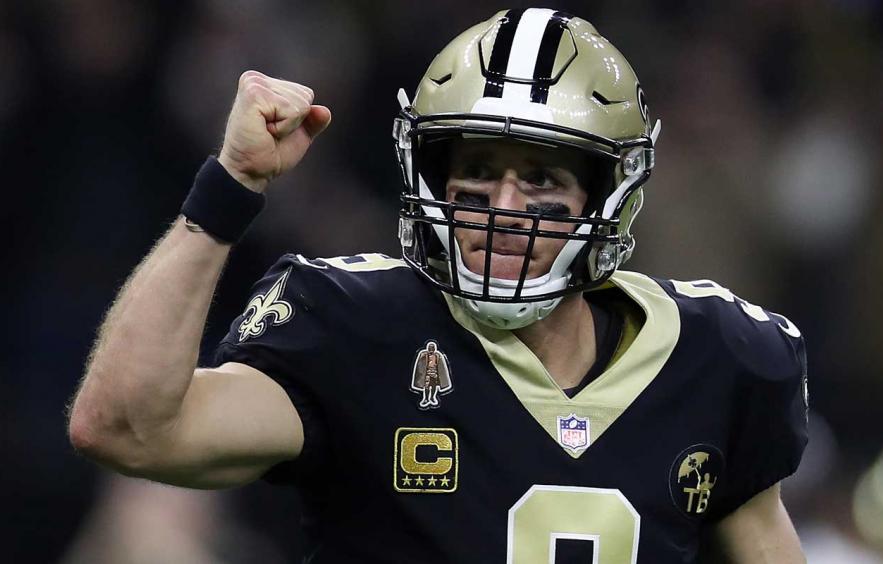QB Draft Strategy: How to Attack the Position in 2018

I don’t know if The Office is the most gif’d television show on the internet, but it feels like the most gif’d show in the fantasy community. We warriors of the fake gridiron have many different favorite teams and players, but most of us root for the Scranton Stranglers on the side. (Apologies to the UK’s Slough Slayers.) The Scott Fish Bowl has two entire conferences devoted to the show (twice as many teams as most other programs), including two separate divisions named after Michael Gary Scott. You get the point.
Editor's Note: For more quarterback coverage and 2QB/Superflex content, check out the 2018 2QB/Superflex Draft Guide from our friends over at TwoQBs.
After the 2009 Super Bowl, NBC led out its coverage of the game with an Office two-parter called “Stress Relief.” The residual euphoria from Pittsburgh’s thrilling win over Arizona likely enhanced my enjoyment of the episode at the time, but it holds up anyway. I have more to say about the episode but feel obligated at this point to expressly warn you of incoming spoilers. Got it? Let’s move on.
More 2018 Positional Draft Strategies: IDP | TE | DST | WR | RB
Part 2 of "Stress Relief" centers around Michael inviting his employees to skewer him in a stand-up roast, and they don’t pull any punches. Naturally, Mike is blindsided like an elite edge rusher, but he humbly sorts through it (by feeding full slices of bread to non-existent birds), just in time to fire back an all-encompassing roast of his coworkers before the credits. Just as Michael finds mostly-fun ways to criticize each of the people in the office, I’m here to do the same for quarterbacks.
*Ahem*
Brandon Weeden is so old, teenage Al Davis used to borrow Weeden’s ID to buy beer. Boom. Roasted.
Okay, I’m a fantasy football analyst, not a comedian, so I’ll leave (most of) the roasting to Dunder Mifflin’s regional manager from here on out. Along the way, I will try to identify analytical warts for even the most appealing fantasy quarterbacks, using 4for4’s tools and other data to illuminate where the best pockets of value tend to settle in drafts. Roll the theme song!
Top-Tier Quarterbacks
“Andy, Cornell called, and they think you suck.”
Yes, Andy graduated from Cornell. But do you need the NFL’s equivalent of ivy leaguers at quarterback to win your fantasy league? I’ll let Michael answer this one:
Late-round quarterback drafting is the status quo these days, and for good reason. Teams around the NFL are embracing the efficiency of passing over rushing, which has led to increased volume for even the most mediocre (and bad) quarterbacks. As a result, those lesser-than options at the position are stumbling into usable fantasy weeks at a steady enough clip to carry our teams.
The elite quarterbacks like Aaron Rodgers, Russell Wilson, Tom Brady, Cam Newton, and Drew Brees give us more usable weeks, but perhaps not as often as you’d expect. Before we get to their specific numbers, here are some simple baselines for top-5, top-10, and top-15 weekly production from quarterbacks:
| 2017 | 2016 | 2015 | 2014 | 2013 | 2012 | 6-Year Avg. | |
|---|---|---|---|---|---|---|---|
|
Avg. Top-5 PPG: |
26.63 |
27.23 |
28.60 |
26.34 |
28.15 |
27.35 |
27.38 |
|
Avg. Top-10 PPG: |
23.41 |
24.06 |
25.08 |
23.08 |
24.29 |
23.76 |
23.95 |
|
Avg. Top-15 PPG: |
21.22 |
21.83 |
22.79 |
21.03 |
21.73 |
21.30 |
21.65 |
|
Avg. QB5 PPG: |
22.93 |
24.14 |
24.89 |
23.17 |
23.84 |
23.14 |
23.68 |
|
Avg. QB10 PPG: |
18.30 |
19.35 |
19.95 |
18.87 |
18.79 |
18.54 |
18.97 |
|
Avg. QB15 PPG: |
15.56 |
16.18 |
16.97 |
15.85 |
15.40 |
15.26 |
15.87 |
Please don’t roast me for giving top-5 and top-10 baselines when analyzing 12-team leagues. Ultimately, these types of cutoffs are all relative. And if you’re in a 12-teamer, do you actually want the 11th-best or 12th-best performers? No, you want differentiation over at least a couple of league mates with a quarterback from the top 10.
Furthermore, we can’t assume all the top quarterbacks will be owned (let alone started) in any given week. That’s why I’ve included top-15 numbers. If we can’t differentiate ourselves with top-5 or top-10 performers, we at least want to avoid punting the quarterback position with outright duds. As you can see, finishing inside the top 15 for any given week means scoring an average of over 21 fantasy points, and the average QB15 scores almost 16 points per week. We’d all be lucky to receive such consistency from our signal-callers.
Boom. Arbitrary endpoints roasted.
Here’s how often the elite tier bested the baselines:
| Player | Avg. Games Played | Over Top-5 Baseline% | Over Top-10 Baseline% | Over Top-15 Baseline% | Over QB5 Baseline% | Over QB10 Baseline% | Over QB15 Baseline% |
|---|---|---|---|---|---|---|---|
|
12.5 |
18.7% |
38.7% |
52.0% |
40.0% |
60.0% |
69.3% |
|
|
15.0 |
15.6% |
24.4% |
35.6% |
26.7% |
47.8% |
60.0% |
|
|
14.3 |
20.9% |
27.9% |
34.9% |
29.1% |
50.0% |
66.3% |
|
|
14.5 |
21.8% |
27.6% |
32.2% |
28.7% |
43.7% |
56.3% |
|
|
14.8 |
21.3% |
28.1% |
32.6% |
28.1% |
52.8% |
66.3% |
There’s a feeling of safety with a set-it-and-forget-it quarterback like Rodgers, but that won’t stop him from burning you 30 to 40 percent of weeks. And that assumes he’s on the field in the first place, which is a whole different concern. Still, these numbers put Rodgers into a tier all by himself as the clear-cut QB1, similar to Rob Gronkowski’s status atop the tight end food chain.
The numbers for Wilson, Brady, Newton, and Brees are good, but they’re also very similar. Without much differentiation between QB2 and QB5 (and saying nothing about the quarterbacks coming later potentially making a leap), there is no incentive to draft any quarterback as the QB2 or QB3 after someone pays up for Rodgers.
If you really want a top-end quarterback, you’re better off focusing on other positions and waiting to see if the draft breaks in such a way for you to grab one of these guys as the QB4 or QB5, but hopefully even later. Don’t pay market price for a quarterback because, as you can see, even the best ones only manage top-10 production about half the time.
Top-Tier Hopefuls
“Dwight, you're a kiss-ass.”
Andrew Luck, Deshaun Watson, and Carson Wentz are Dwight, aspiring to a title they may never get. Together, they make up the most dangerous tier of quarterbacks. After the truly elite passers are drafted (usually too early), a quarterback vacuum is created, and impatient drafters will rush to fill it with second-tier players. We can find reasons to like this range of players, but for the most part, recency bias is the primary driver of hype surrounding them. And ultimately, these players haven’t provided enough evidence they belong in higher tiers with the quarterback elite.
| Player | Avg. Games Played | Over Top-5 Baseline% | Over Top-10 Baseline % | Over Top-15 Baseline% | Over QB5 Baseline% | Over QB10 Baseline% | Over QB15 Baseline% |
|---|---|---|---|---|---|---|---|
|
13.2 |
18.2% |
28.8% |
36.4% |
28.8% |
43.9% |
69.7% |
|
|
7.0 |
42.9% |
42.9% |
57.1% |
42.9% |
71.4% |
85.7% |
|
|
14.0 |
3.6% |
21.4% |
21.4% |
21.4% |
35.7% |
53.6% |
Luck is a bit of an exception in this case, in that he truly has proven the ability to maintain top-level quarterback production. From 2012 to 2016, Luck finished as a top-5 quarterback in three of five seasons, and top-10 in points per game in four of five seasons. Only injury concerns keep him out of the tier above, and the fact he is being discounted based on health is yet another reason to wait beyond the top tier to draft a quarterback. Why pay top-5 prices when you might be able to land equivalent production later with Luck? Don’t break the bank on a quarterback.
Watson and Wentz don’t have the same sort of track record as Luck. Instead, each of them has one injury-shortened season’s worth of unsustainable efficiency, and impressionable drafters expect more of the same in 2018. Among passers to throw at least 100 passes in a season since 2000, Watson’s 2017 touchdown rate of 9.3 percent was the highest mark since Peyton Manning’s MVP season in 2004 (9.9 percent). Wentz's rate of 7.5 percent wasn’t quite as ridiculous, but it was still good for 10th-best by a quarterback with at least 100 attempts since 2000.
While this tier offers similar upside to the top quarterbacks in terms of week-to-week performance, questions about durability and track record make Luck, Watson, and Wentz less trustworthy. And ultimately, those extra risks haven’t generated enough of a discount to make their ADPs palatable. In fact, Watson and Wentz are often drafted ahead of Newton and Brees. When that happens, I can’t blame other drafters for pouncing on the value of more proven players, but it’s usually still better to wait.
The Quarterback Middle Class
Continue reading to see which quarterbacks make up the middle class of Greg's quarterback rankings tier and to see how the rest of his quarterback rankings shake out for the 2018 fantasy season...

- All Premium Content
- The most Accurate Rankings Since 2010
- Expert Draft Picks w/DraftHero
- Highest Scoring Lineup + Top Available Players w/LeagueSync
- ...and much much more






















